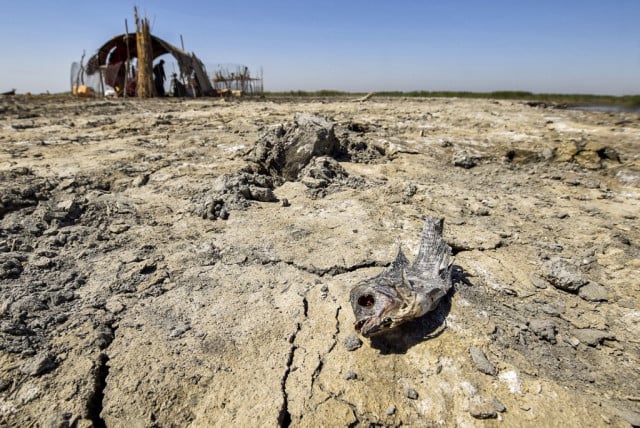Asian Economies Must Ramp up Wind and Solar Power to Keep Global Warming Under 1.5C, Report Says

- By Associated Press (AP)
- November 15, 2023 2:05 PM
HANOI, Vietnam — To meet the goal of limiting global warming to 1.5 degrees Celsius (2.7 degrees Fahrenheit), nine major Asian economies must increase the share of electricity they get from renewable energy from the current 6% to at least 50% by 2030, according to a report by a German thinktank released Wednesday.
Nearly a third of that renewable energy should come from wind and solar power, said the report by researchers of Berlin-based Agora Energiewende. A fifth would be hydropower and other clean sources and the remainder, fossil fuels.
The study analyzed energy plans of both developing nations like Indonesia and Vietnam where demand for energy is growing rapidly, and wealthier places like Japan and South Korea, which have among the highest burdens of per capita greenhouse gas emissions. It did not include China, the world's biggest emitter of carbon, or India, another major contributor.
A global temperature increase of 1.5C (2.7F) since pre-industrial times is considered a critical climate threshold beyond which risks of catastrophes rise. The world will likely lose most of its coral reefs, a key ice sheet could kick into irreversible melt, and water shortages, heat waves and death from extreme weather may surge, according to an earlier United Nations scientific report.
Agora Energiewende researchers found that Asian nations are united in their heavy reliance on fossil fuels and national plans are not aligned with ambitious climate pledges announced by their governments.
By using proven technologies like wind and solar power, countries can avoid exceeding limits they have set and also limit investment in fossil fuel infrastructure they won't need, said Mathis Rogner, the Southeast Asia project lead for Agora Energiewende and a co-author of the report.
To conform with 1.5C (2.7F) limit, the nine countries included in the study need to add 45 to 55 gigawatts of solar energy and 20 gigawatts of wind energy every year. In 2021, they had installed a total of just 11.9 gigawatts of solar energy and 1.5 gigawatts of wind energy.
The study reviewed energy plans of Japan, South Korea, Vietnam, Indonesia, the Philippines, Thailand, Pakistan, Bangladesh, and Taiwan.
A gigawatt is roughly the amount of energy a nuclear power plant produces in a year.
As of the end of 2022, the U.S. had installed capacity of more than 144 GW of wind power and 110 GW of solar photovoltaic power.
The need for urgent action was echoed by United Nations Secretary-General Antonio Guterres who called for a “climate ambition supernova” after a U.N. analysis released Tuesday found that countries’ climate plans still lagged far behind what was needed.
Much of the clean energy capacity the world has added since 2016 has been concentrated in the U.S., China and India. Even though wind and solar technologies have been getting cheaper every year, among other Asian nations, only Japan and Vietnam derive more than a tenth of their capacity from the wind and the sun.
The vast increases in Chinese and Indian renewable energy capacity have to some degree obscured how much many other Asian countries lag behind, said Kanika Chawla, chief of staff at Sustainable Energy for All, the United Nations’ sustainable energy unit.
But they also show how such transitions can create jobs and improve energy security, said Chawla, who was not involved in the report.
Many countries still rely heavily on large hydropower dams, which can involve hefty social and environmental costs and are vulnerable to drought.
The report estimates that South Korea, Thailand, and Indonesia each should add between 8 and 14 gigawatts of solar power annually. Indonesia now gets less than 1% of its power from wind and solar energy, according to a study by the U.K.-based thinktank Ember. South Korea and Thailand also still mostly depend on fossil fuel.
Japan needs to add an average of 9 gigawatts of solar power a year and Vietnam, around 10 gigawatts, to meet end-of-the-decade targets. But the report says the goals are achievable since both countries have managed similar increases in the past.
The report says Pakistan, Bangladesh and the Philippines need to add between 1 and 3 gigawatts of energy from the sun each year to their grid.
South Korea needs the biggest spurt in wind power — an average increase of 8 gigawatts each year — while Japan needs to add about 3 gigawatts. Vietnam should be deploying around 4 gigawatts in new wind power capacity, the report said.
Lower potential for wind power in other countries means they should target between one and 2 gigawatts each year.
The report calls for a “paradigm shift” to speed up the transition to wind and solar power. That would include removing subsidies for oil and gas that make renewables less competitive, simplifying bureaucratic hurdles such as permits and facilitating investments.
At the same time, power grids need to be upgraded to allow for the variability and unpredictability of wind and solar power, it said.
Despite a common misconception that wind and solar are more expensive and less stable than fossil fuel-powered generation, “Our analysis shows that often much higher shares of wind and solar can be reliably integrated into the power system than the operators expect,” Rogner of Agora said.















